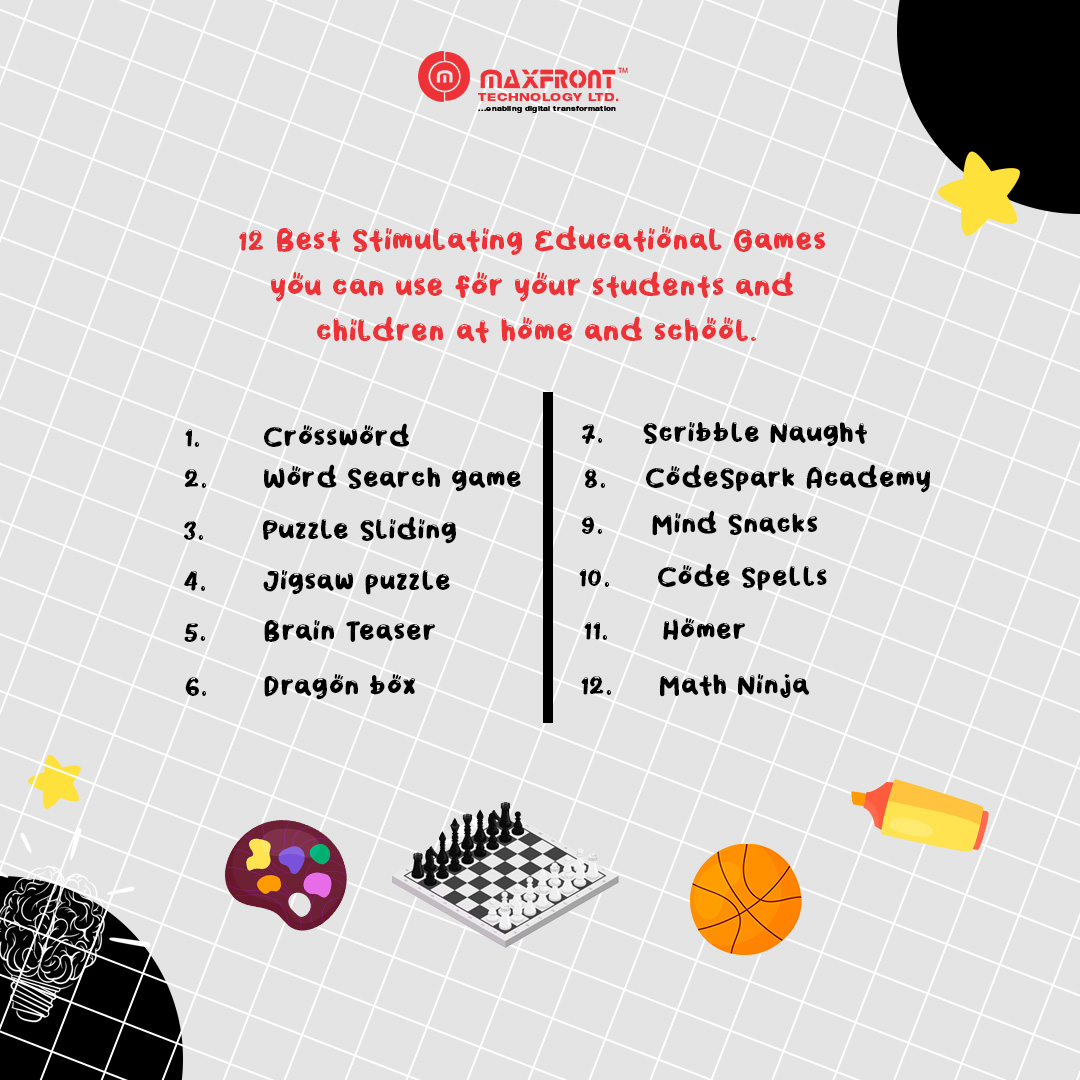Children can learn various skills through playing games, including interaction, critical thinking, creativity, teamwork, and good sportsmanship. Students should be encouraged to attempt novel teaching approaches so that learning is more diversified and is not limited to cramming or rote memorization.

By utilizing the enthusiasm and creative thinking that come with using technology in the classroom, teachers may help children perform better. Educational institutions, schools, and families can use educational games in various contexts. The primary goal of instructional games is to foster critical thinking while educating students about a particular subject.
Games like chess are not considered educational since they do not offer information or convey curriculum material. However, they promote logical abilities, thinking, and other attributes desired in education. Other games that can improve understanding in a specific area include math games.
Benefits of Games on Students
- The primary goal of incorporating technology in education is to engage pupils and encourage them to participate. Games can help students become more engaged by fostering a hands-on approach. Students learn visual and computer literacy abilities from playing games, which will help them succeed in the workplace.
- Pupils may use games to help them recall fundamental principles they can use in exams and real-life situations. This is critical because we live in an age when innovation is king. Games in education are intended to aid pupils in remembering what they have learned.
- Students are encouraged to think outside the box, so they can readily apply what they’ve learned in class to real-life circumstances. According to research, web-based games have been shown to help children with attention issues. Through games, students can learn other abilities like critical thinking, problem-solving, and sportsmanship.
- Students with attention and focus problems will benefit from playing computer games. Games are also beneficial as instructional aids since they brighten up teaching approaches that are termed dull and monotonous.
- Games are an enjoyable form of learning and can help attract kids’ attention. Students must follow regulations to get a high score and advance to the next round of in-game drills.
Here are the 12 Best Stimulating Educational Games you can use for your students and children at home and school.

1. Crossword
A crossword puzzle is a word problem that must be solved by using clues. Crossword puzzles are one of the most widely played games worldwide. General knowledge testing, they’re most commonly found in newspapers and periodicals. Students will be provided with across and down hints on the most important historical events based on the topic that will be addressed during face-to-face instruction. They must fill in the words or sentences using the rules and within the time limit to complete the crossword puzzle. This improves their visual literacy as well as their understanding of the subject. Crossword puzzles help with the revision component of studying history since only clues are offered, and students must work out the remainder independently.
2. Word Search game
The game of word search is a puzzle in which words are randomly put in a box and must be found. Finding and marking each word inside the box is the goal of this puzzle; you can alter the maximum time allowed based on the level selected. While constructing the word search, several difficulty levels, such as easy, medium, or hard, may be selected. Students must know and recall crucial terms when using word searches.
3. Puzzle Sliding
A sliding puzzle is a tile problem in which the player must slide pieces along a predetermined path to restore the picture to its original configuration. Students can discuss the meaning of the picture they solved in the comment box at the bottom of the page. This sort of puzzle can assist students in revising and recalling historical events in a visual style.
Instructors can choose and upload a picture based on themes addressed in face-to-face training and a description of the discussion topic. Selecting multiple difficulty levels is also possible throughout the design stage. Students can use the comments area to debate the topics presented at the bottom of the puzzle.
4. Jigsaw puzzle
A jigsaw puzzle is a puzzle made up of several pieces that have been cut into various shapes and may be assembled to form an image. Employing technology in education is to create a whole student with visual, technological, and knowledge literacy. Jigsaw puzzles are an excellent tool for teaching pupils a variety of skills. Students can choose from various difficulty levels depending on how challenging they wish to be. The better a student’s score, the less time they spend solving the task. Students can share their results with friends once the jigsaw puzzle is completed.
5. Brain Teaser
The brain teaser is a trivia game that will help pupils review and focus on essential topics to retain what they’ve learned. Students can also talk about the important keywords at the bottom of the page and ask for assistance based on the teacher’s clues.
A brain teaser is a challenge that stimulates pupils’ thinking. It allows pupils to utilize their brains in unusual ways by providing riddles or hints. Brain teasers are inquisitive and offer the ideal platform for reviewing history in preparation for exam time.
6. Dragon box
Algebra is one of the most challenging subjects to learn, and many pupils struggle with it due to its intricacy and monotony. Dragon Box is a perfect learning game for all those pupils who need to solve equations to understand the principles behind things. This game makes Algebra fun for youngsters by including visual aspects. Students must eliminate the unneeded components and balance an equation as part of the game. The remarkable aspect of this game is that kids gradually forget they are doing a math problem. Everything appears to be a game.
7. Scribble Naught
Students may use this game for creative challenges such as spelling and vocabulary. Players are presented with obstacles that they must overcome using their imagination. Students can even do their puzzles that they can share with their peers. This game encourages students to be creative on the spur of the moment and is a great way to challenge yourself.
8. CodeSpark Academy
CodeSpark Academy is a new app for kids that allows them to program video games and interactive stories. The app offers daily activities tailored to a kid’s growth, which keeps them interested and motivates them to participate in the classroom.
CodeSpark Academy app focuses on developing STEM and future-oriented skills in a fun and engaging way. This learning game software offers a stepping stone for young children aged five and older, from playing games to developing and inventing their games.
9. Mind Snacks
Mind Snacks is more effective than textbooks at feeding foreign languages to pupils through enjoyable and playful games. In the player’s mind, repetition generates a memory of a word or phrase. Children can play this game while traveling, in line, or at any other time.
10. Code Spells
Code Spells is an educational video game for kids who aspire to be computer coders. Use Code Spells to make coding a joyful activity, even if it’s not a big topic.
11. Homer
Homer is a well-known learning games app that aims to provide an exciting and enjoyable learning experience. It contains lessons in reading, arithmetic, creativity, and critical thinking, among other subjects. The library offers the youngsters a specialized reading curriculum that develops with them as their reading skills advance.
12. Math Ninja
The game’s long-running style presents problems that a ninja must overcome using the answers that the player discovers. Students can recall mathematical knowledge by repeating arithmetic tasks and using a creative approach. You may play Math Ninja on the iPad to test your understanding of complex multiplication and division.
Utilizing games in the learning process can help students understand what is happening around them and provide real-time feedback on how well they are doing. Games foster teamwork and collaboration and provide a safe environment for students to experiment. It positively impacts education as they make learning more engaging and interactive. They improve various skills, such as problem-solving, critical thinking, and decision-making. You can customize these educational games to target specific learning objectives, such as helping students understand and retain information better.
In summary, the effectiveness of a technology tool is determined by how well it solves the desired instructional goals. You can use numerous games in the learning process, including problem-solving, drill and practice, simulation, puzzle, and tutorial-based games to teach a wide range of subjects, such as mathematics, science, history, language, and critical thinking skills.